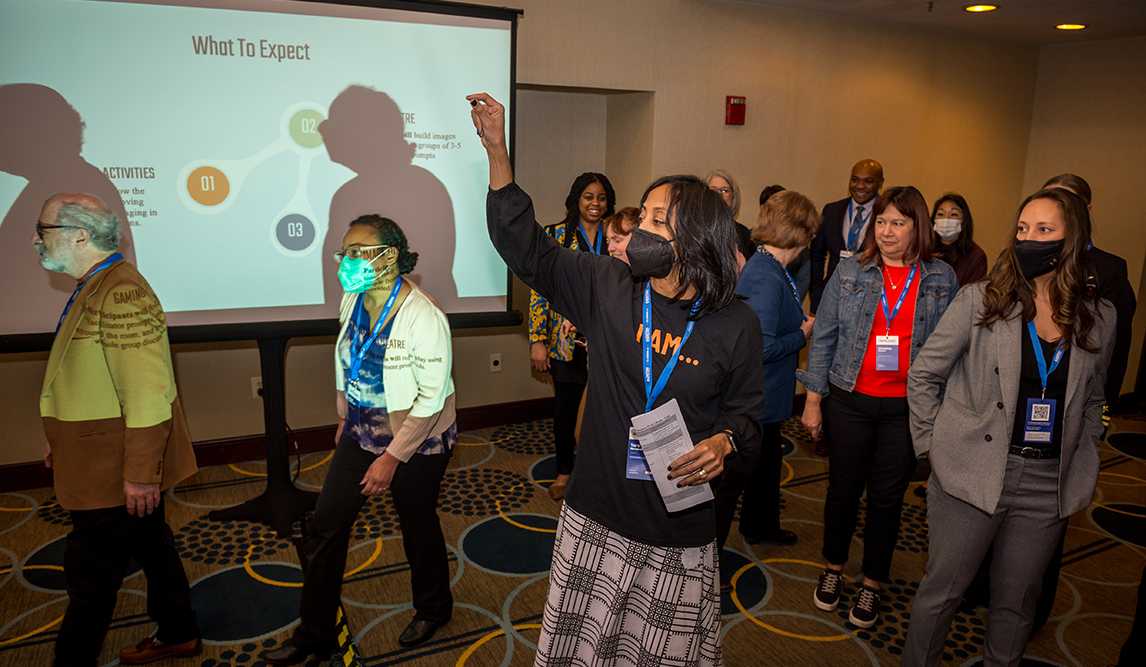DSEC Partners Work Together to Address Inequities in STEM Learning
28 Nov 2023
The First Question to Ask is “What Does Equity Look Like for You?”
Four Defense STEM Education Consortium (DSEC) partners are collaborating on a professional development program to launch teachers as STEM Equity Ambassadors in their communities. This blog introduces the program and is first in a three-part series. Part two will detail how participants developed STEM equity plans, and part three will share plan specifics as well as how other educators can find and develop solutions for their own gaps in STEM equity.

Dr. Tara Nkrumah facilitates a learning session using dramatization techniques during the 2023 DoD STEM Technical Exchange in Washington, DC.
In STEM learning, “inequity” is a broad term and means different things to different people. To help STEM educators define what inequity in STEM education looks like in their locale—and just as importantly, what educators can do about it—four DSEC partners have embarked on a year-long collaboration funded by a DoD STEM Innovation Bloc grant.
The partnership between Alamo STEM Ecosystem, Arizona State University's (ASU) Mary Lou Fulton Teachers College, Teaching Institute for Excellence in STEM (TIES), and Learning Undefeated uses interactive and experiential teaching methods to support 32 teachers as they develop a robust STEM Action Plan for their own school and school districts.
The program, “Cultivating STEM Equity Ambassadors to Address the Barriers to Equity in STEM Education,” uses virtual and in-person sessions to identify ways individual STEM educators can impact persistent underrepresentation in areas such as race and gender in STEM fields. The program focuses intently on the student experience and encourages educators to create space for understanding what equity means for the individual. One size does not fit all.
Program participants will take part in dramatization techniques known as “Theatre of the Oppressed,” 1 the purpose of which is to allow people without formal theatre training to explore social issues such as oppression or exploitation. The techniques are known to help people learn about experiences not universally shared by all members of a given group.
STEM Equity Ambassador Program participants started out by considering the following:
Q. Do I understand the problem in my location? Do I understand that equity is imperfect?
Q. What are the causes of inequity where I teach?
Q. How am I defining the problem? How do my colleagues define the problem?
Participants learn that how a problem is defined will drive the solution(s). They also learn not to assume that everyone is operating within the same parameters. For example, in the first virtual session, participants described their understanding of why there is race and gender underrepresentation in STEM education through responses ranging from “students don't know what STEM is” to “socioeconomic status can determine access to opportunities.” It is important to understand that problems are complex, and stakeholders might even work against each other if they don't find common ground for working toward solutions. Participants will continue to delve into these issues throughout the program.
“Educators can be learners! And equity definitely has to be learned,” says Dr. Tara Nkrumah, program lead and assistant professor of teacher preparation at ASU's Mary Lou Fulton Teachers College. Nkrumah helps teachers nationwide explore culturally relevant and responsive leadership. “Do not assume that we understand,” she continues. “This type of learning cannot be taught, it has to happen through action. It is a process and must involve the community affected.”
The three other partners bring different areas of expertise to the program, such as informal learning opportunities in after-school or summer STEM camps, faculty externships, deep experience with military-connected students, and STEM lesson plan training and development, to name a few. Each partner will lead a team of eight teachers in auditing their own school programs, designing new curriculum, and planning programs to engage students, teachers, families, and communities. Each participant will earn a DoD STEM microcredential in STEM equity.
Nkrumah says learning how to implement equity is hard work and can be humbling for skilled educators. The course will help educators:
- Become comfortable with not knowing how audiences view the issue
- Become comfortable being corrected by students (or any audience)
- Realize that sometimes educators need to unlearn what they've been taught about educating, and learn that they don't have to have all the answers
- Allow space for people to share their own experiences
- Understand that equity means answering the question “What does this person need in order to learn STEM?”
- Realize that equity is not the same as equality
1 Note: Brazilian author Augusto Boal outlines these techniques in the book Theatre of the Oppressed (Pluto Press, 1979).
About DoD STEM and Defense STEM Education Consortium
Defense STEM Education Consortium (DSEC) is a collaborative partnership of STEM-focused organizations dedicated to addressing and prioritizing our nation's STEM talent. DSEC aims to broaden STEM literacy and develop a diverse and agile workforce with the technical excellence to defend our nation. Through strategic investment in STEM education and outreach activities, the effort will provide students with more exposure to educational and career opportunities as well as DoD research. DSEC is led on behalf of DoD STEM by RTI International.